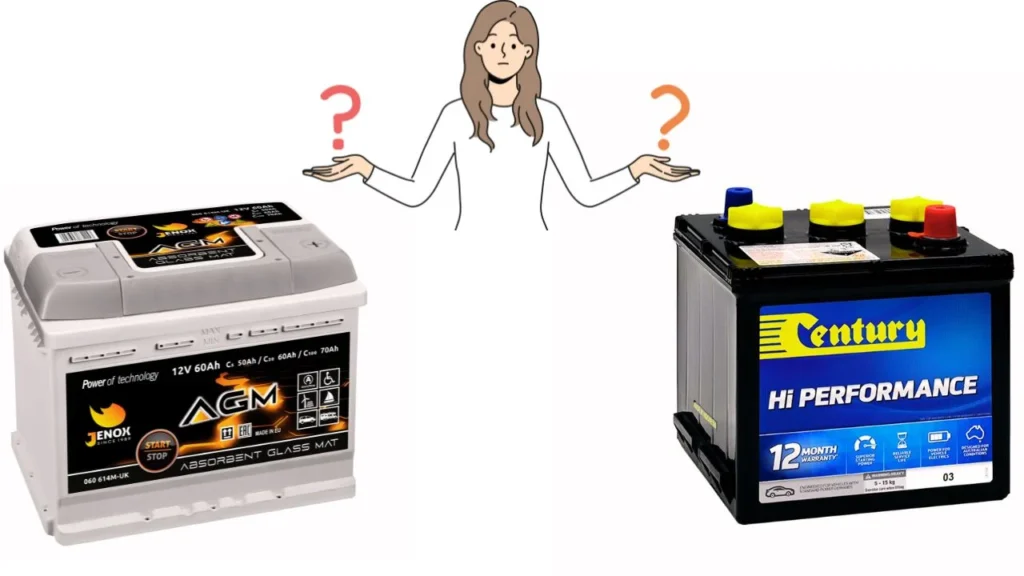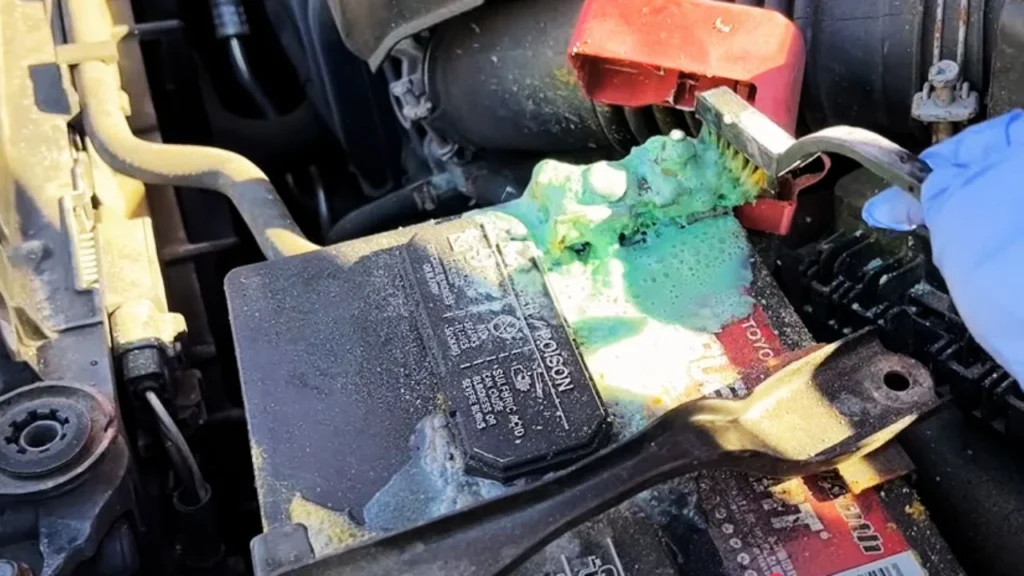Understanding AGM vs standard battery charging is key to keeping your battery healthy and lasting longer. AGM batteries can charge up to 5 times faster than standard ones thanks to their advanced design, while standard batteries have been reliable for over 150 years.
Proper charging practices can extend AGM batteries’ lifespan to 6–8 years compared to 3–5 years for standard batteries. A small mistake, like overcharging, could reduce their performance and shorten their lifespan. Let’s break this down so you can get the most out of your battery. Learn more in our guide on battery chargers vs. jump starters for a complete comparison.
What are AGM and Standard Batteries?
What is an AGM Battery?

AGM stands for Absorbed Glass Mat, a design where the electrolyte is held in fiberglass mats instead of freely flowing. This means no spills, no leaks perfect for vehicles that experience vibrations, like off-roaders or motorcycles.
AGM batteries charge up to 5 times faster than standard ones, making them super efficient. They also have a lower self-discharge rate, around 1-3% per month, so they hold their charge longer when not in use. Lifespan? Typically 5-7 years if maintained properly. Learn more in our guide on the best NOCO battery chargers for cars for expert recommendations.
What is a Standard Battery?

Standard batteries, also called flooded lead-acid batteries, have been around for over 150 years. They use liquid electrolytes, which means they need occasional maintenance, like checking water levels.
They’re affordable and can last 3-5 years, but they charge slower than AGM batteries. Plus, they’re more sensitive to vibrations, so they might not last as long in tough conditions. Learn more in our guide on the best car battery chargers for dead batteries for reliable options.
Key Differences in Charging AGM vs Standard Batteries

1. Charging Speed and Efficiency
- AGM batteries charge up to 5 times faster than standard batteries due to their lower internal resistance.
- Standard batteries are slower, often taking 8-10 hours for a full charge compared to just 2-3 hours for an AGM battery.
2. Voltage Sensitivity
- AGM batteries require precise voltage regulation, typically in the range of 14.4 to 14.8 volts, to avoid overcharging and overheating.
- Standard batteries are more tolerant of minor voltage fluctuations but can still suffer from damage if overcharged.
3. Self-Discharge Rates
- AGM batteries have an impressively low self-discharge rate of 1-3% per month, making them ideal for vehicles or equipment stored for long periods.
- Standard batteries, by comparison, discharge at a higher rate of 5-15% per month, requiring more frequent charging.
4. Maintenance Needs
- AGM batteries are maintenance-free, eliminating the need to check electrolyte levels or top up with distilled water.
- Standard batteries demand regular maintenance, including checking electrolyte levels and ensuring proper ventilation during charging.
5. Temperature Performance
- AGM batteries excel in cold climates, providing reliable power and fast charging even at temperatures below 32°F (0°C).
- Standard batteries tend to lose efficiency in extreme cold, making them less reliable in harsh weather conditions.
6. Overcharging Risks
- Overcharging an AGM battery can significantly shorten its lifespan, as these batteries are more sensitive to voltage spikes.
- While standard batteries are slightly more resilient, overcharging still causes issues like electrolyte evaporation and overheating.
7. Lifespan Impact
- Proper charging practices extend the lifespan of AGM batteries to 6-7 years on average.
- Standard batteries generally last around 3-5 years, depending on maintenance and charging habits.
How AGM Batteries Charge

AGM batteries charge faster and more efficiently due to their low internal resistance of around 2%, compared to 10-15% in standard batteries. They work best within a voltage range of 14.4 to 14.8 volts during charging, and exceeding this can lead to overcharging or reduced lifespan.
Additionally, AGM batteries can handle higher current rates, charging at 30-40% of their capacity. For instance, a 100Ah AGM battery can take up to 30-40 amps, making it much quicker than standard battery charging. Learn more in our guide on the best solar car battery chargers with overcharge protection for efficient and safe charging solutions.
When considering AGM vs Standard Battery Charging, precision is key. AGM batteries need controlled voltage and are sensitive to extreme temperatures. Charging them below 0°C (32°F) or above 40°C (104°F) can harm performance. Stick to a smart charger with an AGM setting, and you’ll ensure efficiency and longevity while maintaining their fast-charging advantage. Learn more in our guide on how long to drive a car to charge the battery for additional insights.
How Standard Batteries Charge

Fellows, standard batteries take their time to charge typically 8–12 hours because of their higher internal resistance. The ideal charging voltage is around 14.4–14.8 volts, and staying within this range is important to avoid damage.
Temperature plays a big role too! If the battery gets too hot, above 45°C (113°F), it can cause the electrolyte to evaporate quickly, leading to performance issues. Charging in cooler conditions, around 20–25°C (68–77°F), is ideal for better efficiency and longer battery life.
Unlike AGM batteries, standard batteries need a bit more care. You’ll need to keep an eye on the electrolyte levels, as evaporation can occur during charging. Plus, they release gases like hydrogen, so always charge them in a well-ventilated area to stay safe. That’s another important distinction in AGM vs Standard Battery Charging! Learn more in our guide on how long to charge a car battery with a charger for detailed insights.
Similarities Between AGM and Standard Battery Charging
- Both are Lead-Acid Batteries
AGM and standard batteries use the same lead-acid technology, making certain charging principles universal. - Voltage Regulation is Essential
Both require a charging range of 13.8V to 14.4V. Overcharging can damage both types. - Temperature Impacts Charging
Extreme cold (below 32°F/0°C) or heat (above 113°F/45°C) reduces charging efficiency for both. - Self-Discharge Occurs Naturally
AGM batteries lose 1-3% charge monthly, while standard batteries lose 5-10% when idle. - Both Require Testing
Periodic voltage checks help maintain performance for both types, even AGM batteries labeled as “maintenance-free.” - Overcharging Causes Damage
Excessive charging leads to overheating and reduced lifespan for both AGM and standard batteries. - Environmental Factors Play a Role
Humidity, vibrations, and improper storage affect both batteries’ charging efficiency and longevity.
Lifespan: How Long Do They Last?
Hey buddy! Let’s start with how long these batteries stick around. AGM batteries are the champs here, lasting up to 6–8 years with proper care. Standard batteries, while reliable, typically last around 3–5 years.
But remember, charging habits are key. Overcharging an AGM battery can slash its lifespan by 20–30%. Meanwhile, neglecting a standard battery like forgetting to check electrolyte levels can cut its life short too. Treat them right, and they’ll serve you well!
Maintenance: Keeping Your Battery Happy and Healthy

Taking care of your battery isn’t rocket science, but it makes a big difference in how long it lasts. Here’s how you can maintain AGM and standard batteries to keep them working like new:
AGM Battery Maintenance
AGM batteries are low-maintenance, but they still need some attention:
- Clean the terminals: Dirt and corrosion can still build up, so give the terminals a quick clean every few months.
- Use the right charger: AGM batteries are sensitive to overcharging. Always use a smart charger with an AGM setting to avoid damage.
- Check charge levels regularly: Even though AGMs have a low self-discharge rate (only 1–3% per month), it’s good to ensure they’re fully charged if you’re not using them for a while.
Standard Battery Maintenance
Standard (flooded lead-acid) batteries need more regular care to stay in good shape:
- Monitor electrolyte levels: Open the caps and make sure the liquid covers the internal plates. If it’s low, add distilled water never tap water, as it contains minerals that can harm the battery.
- Ventilation during charging: These batteries release gases while charging, so make sure there’s proper airflow to prevent buildup.
- Keep the terminals clean: Corrosion can reduce performance. Use a baking soda and water solution to clean the terminals every couple of months.
- Store properly: If not in use, store your battery in a cool, dry place. Extreme heat or freezing cold can drain its charge quickly.
Conclusion
Proper maintenance and understanding of AGM vs standard battery charging can significantly extend your battery’s lifespan. AGM batteries require precise voltage control, while standard batteries need regular electrolyte checks. Both types benefit from proper cleaning, storage, and avoiding overcharging. A little care ensures reliable performance and keeps your battery healthy for years to come!
FAQs
Q1. Can I use the same charger for AGM and standard batteries?
No, AGM batteries need a charger with precise voltage control, like a smart charger, to avoid overcharging. Standard batteries can work with basic chargers, but it’s still best to match the charger to the battery type.
Q2. How do I know if my battery is AGM or standard?
AGM batteries are sealed and usually labeled “AGM” on the case. They don’t have removable caps, unlike standard batteries, which have visible liquid and caps for checking electrolyte levels.
Q3. Do AGM batteries charge faster than standard batteries?
Yes! AGM batteries charge up to 5 times faster due to their lower internal resistance. Standard batteries take longer to charge, making AGM more efficient for quick power needs.
Q4. What happens if I overcharge an AGM battery?
Overcharging an AGM battery can cause overheating, swelling, and permanent capacity loss of up to 15–25%. Always use a charger with an automatic shut-off or AGM-specific setting to prevent damage.




